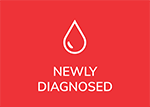At ASH 2018, combination therapies were the big buzz, as discussed in several other interviews.
Dr. Nitin Jain is a member of the strong CLL treatment and research team at MD Anderson Cancer Center (MDACC), Houston, TX.
We reconnected at ASH 2018, where I interviewed Dr. Jain about his single-center trial at MDACC that combined arguably the best two drugs we have today for treating chronic lymphocytic leukemia, namely ibrutinib and venetoclax in treatment-naïve high-risk chronic lymphocytic leukemia (CLL) population that needed to start therapy.
There are several other trials looking at this same combination, including CAPTIVATE and CLARITY, with slight variations.
Takeaways:
- 80 patients were studied. All were treatment naïve. 92% had either an unmutated IGHV or TP53aberration or del(11q).
- Patients received ibrutinib monotherapy (420 mg daily) for 3 cycles (3 months), followed by the addition of venetoclax (weekly dose-escalation to a target dose of 400mg daily). Combined therapy was administered for 24 cycles (two years) and then stopped.
- At one year, 23/25 (92%) of the patients were in CR/CRi (complete remission/complete remission with incomplete recovery of all the blood count.)
- 17/25 (68%) achieved U-MRD (undetectable minimal residual disease) in the bone marrow.
- 80% of those with del 17p were U-MRD at 12 months.
- Three patients had laboratory evidence of tumor lysis syndrome (TLS). None had clinical TLS suggesting that the 3-month ibrutinib lead-in led to a lower tumor burden, thus decreasing the risk of TLS.
- 11 (14%) discontinued the trial.
- Grade 3-4 neutropenia (low neutrophil count) occurred in almost half of the patients. The potentially more serious neutropenic fever occurred in 5% of patients.
- Atrial fibrillation occurred in 14% of patients.
- The dose of ibrutinib was reduced by 35%; venetoclax was dose-reduced by 18%.
Conclusions and Unanswered Questions:
Clearly, venetoclax and ibrutinib are a safe, potent, and appealing non-chemo combination as proven now in several clinical trials, including this one. Remember that 92% of patients were high risk, and they responded well.
It is also clear that the intention is to be able to safely stop the medications. This offers several advantages, certainly saving money and reducing side effects, but also perhaps lowering the risk of developing resistant mutations.
When to stop is the unanswered question. Different trials use different stopping points—some use reaching U-MRD, and others use two years. We don’t know which is the best approach.
What we want are durable remissions. Logic and some related data suggest that reaching U-MRD should best predict lengthy progression-free and overall survival.
But what should be done for patients that don’t get there at 2 years? Do we continue? For how long?
It is pretty exciting that we are able to start asking these kinds of questions about fixed duration non-chemo approaches that offer the promise of extended control of our CLL.
Here is the link to the ASH abstract: Combined Ibrutinib and Venetoclax in Patients with Treatment-Naïve High-Risk Chronic Lymphocytic Leukemia (CLL).
Stay strong. We are all in this together
Brian Koffman

















